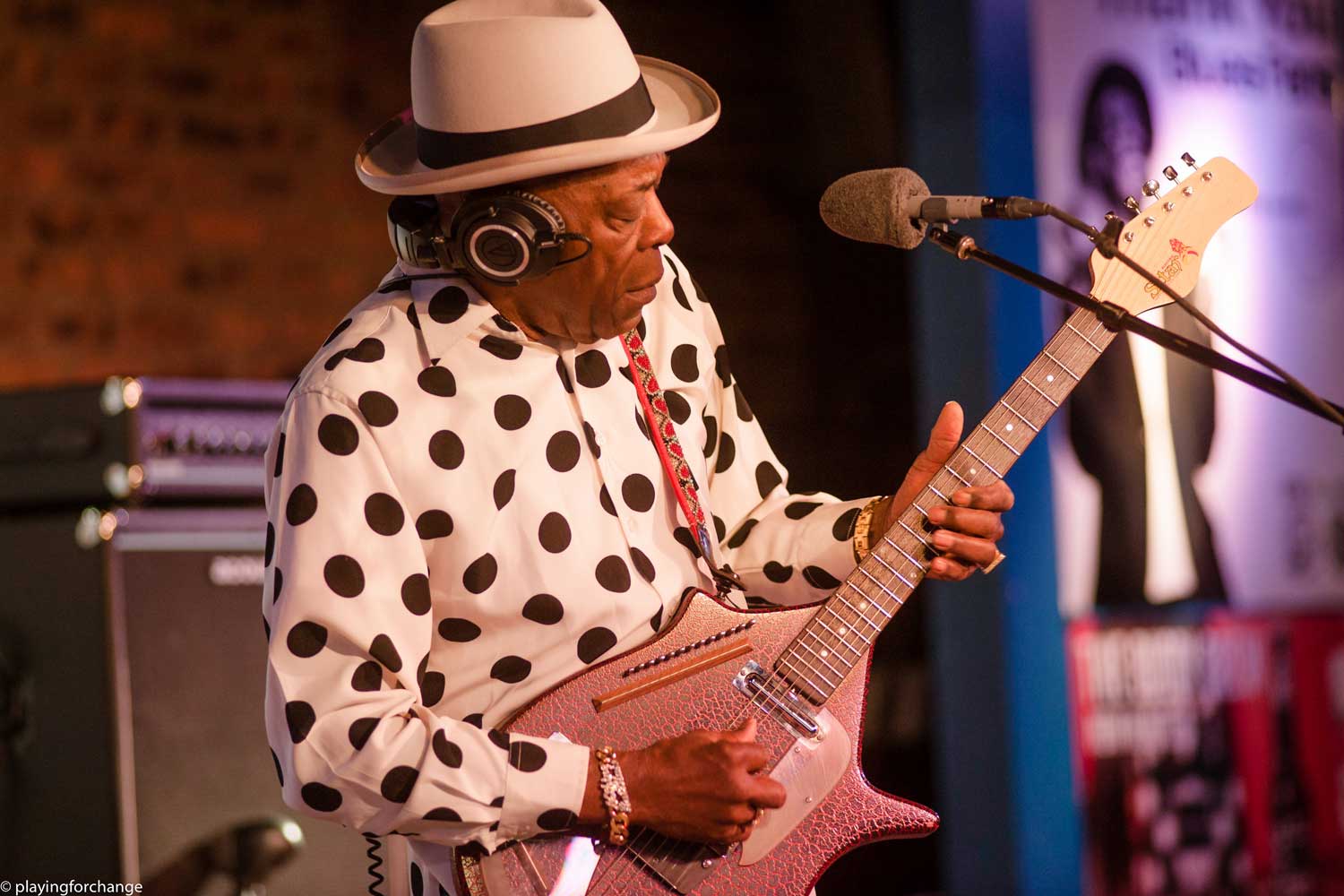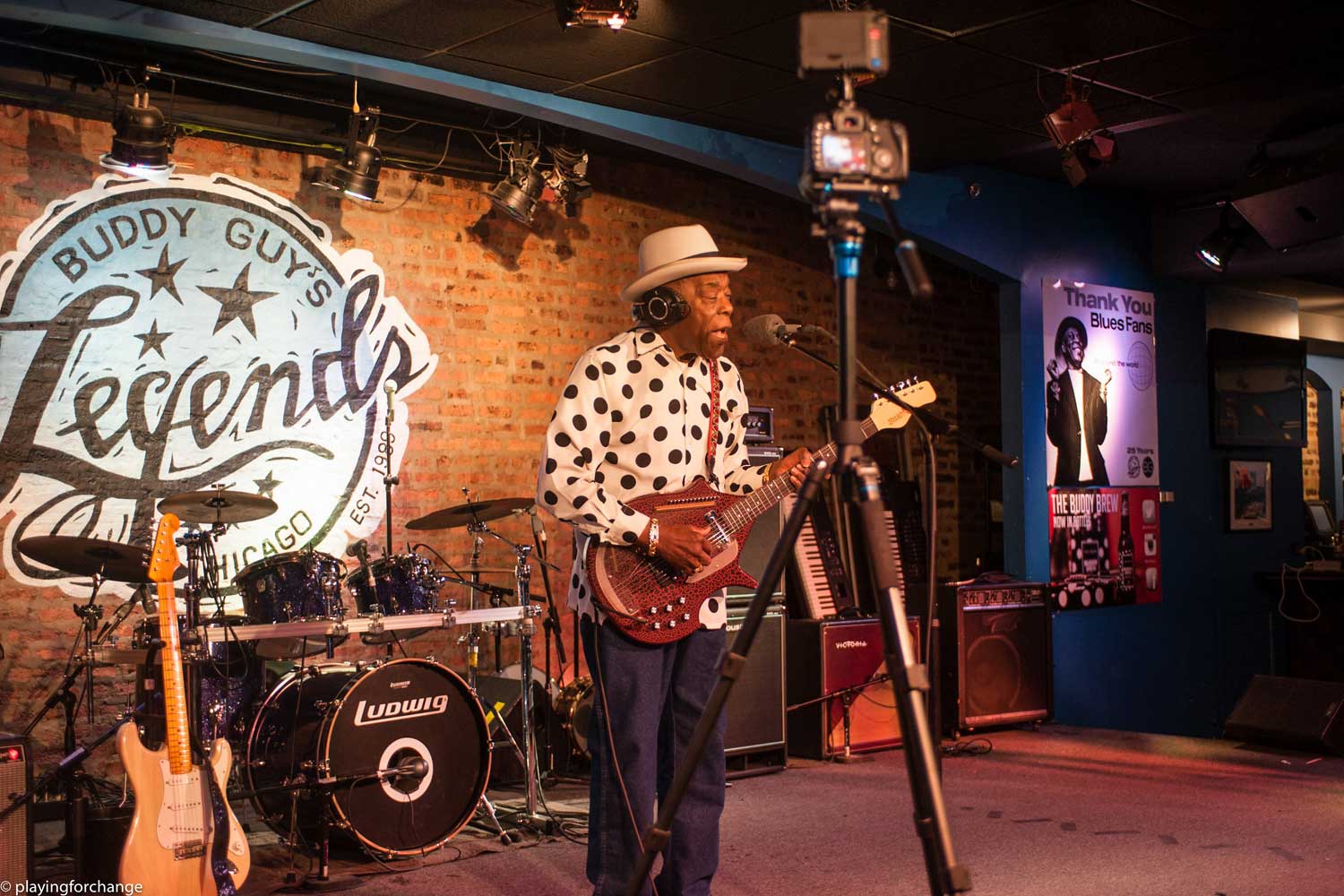Biography
“Every time we would finish a session,” says Buddy Guy, “if everybody felt good about it, we’d say, ’Let’s do another.’ You need about 14, 15 songs for an album, but we had passed 18 songs and I said, ‘Man, when is this going to be over?’ But they kept throwing songs at me, and every damn thing we cut sounded pretty good. I got the word back that the label thought maybe it was a good idea to put two CDs out—one of them the slow stuff, more for listening, and the other, like B.B. King said, if you want to boogie-woogie all night long.”
The result has a title both simple and clever: Rhythm & Blues, the first double-album set of his storied career. But more than five decades into a life as one of the world’s leading bluesmen, Buddy Guy is used to new surprises, challenges, and accolades.
At age 76, he’s a Rock and Roll Hall of Fame inductee, a major influence on rock titans like Jimi Hendrix, Eric Clapton, and Stevie Ray Vaughan, a pioneer of Chicago’s fabled West Side sound, and a living link to that city’s halcyon days of electric blues. He has received 6 Grammy Awards, 28 Blues Music Awards (the most any artist has received), the Billboard magazine Century Award for distinguished artistic achievement, and the Presidential National Medal of Arts. Rolling Stone ranked him in the top 25 of its “100 Greatest Guitarists of All Time.”
Read more
The last year, in fact, has proven to be one of Guy’s most remarkable ever. He was awarded the 2012 Kennedy Center Honors for lifetime contribution to American culture; earlier in the year, at a performance at the White House, he even persuaded President Obama to join him on a chorus of “Sweet Home Chicago.”
Also in 2012, he published his long-awaited memoir, When I Left Home, and released Live at Legends, which has been nominated for Best New Recording in the Living Blues Awards. Meanwhile, Guy keeps looking to the future of the blues through his ongoing work with his 14-year-old protégé, Quinn Sullivan.
Now the story continues with Rhythm & Blues, 21 tracks which feature contributions from a stellar and wide-ranging set of guests, including Steven Tyler, Joe Perry, and Brad Whitford of Aerosmith and rising guitar wizard Gary Clark, Jr. “If you watch a ballgame, it seems like those guys are angry at one another, but when they finish playing, they go out and have drinks together,” says Guy. “Musicians were doing that before anybody—we don’t have rivals as far as who can outplay who, but we have so much fun letting other people think that’s what it is. So it’s really a blessing to have all of these guys on here.”
He had a specific inspiration for a duet with his friend Kid Rock, realizing that “Messin’ with the Kid”—a 1960 hit for Guy’s long-time partner Junior Wells—was a perfect fit lyrically and musically. “I was surprised he hadn’t gotten there himself,” says Guy. “I saw him at the White House and I thought, ‘I ain’t gonna tell him, ’cause he might go and do it himself, I’m going to wait until I can do it!” I threw it at him and he jumped the fence—he did a hell of a job with it.”
Probably the most unexpected guest on Rhythm & Blues (which was produced by Guy’s frequent collaborator Tom Hambridge, and recorded at Nashville’s Blackbird Studios) is country superstar Keith Urban, who joins Guy on an emotional ballad called “One Day Away.” Guy maintains that he was well aware of Urban’s instrumental prowess before they teamed up. “I listen to everything, regardless of what type of music it’s branded,” he says. “If I hear a guitar that makes me pat my feet, and try to not go to sleep ’cause I’m afraid I might miss something, it’s all right with me. Any guy who can think about playing music is a friend of mine, and the door is always open.”
One song in particular jumped out at Guy, a funky travelogue called “Meet Me In Chicago” written by slide guitar maestro Robert Randolph. “I really fell in love with that one,” he says. “I been in Chicago 56 years—that sounds just like me. It’s not really blues, but it’s a good beat, so I wanted to see if I could do something with it.”
Though Buddy Guy will forever be associated with Chicago, his story actually begins in Louisiana. One of five children, he was born in 1936 to a sharecropper’s family and raised on a plantation near the small town of Lettsworth, located some 140 miles northwest of New Orleans. Buddy was just seven years old when he fashioned his first makeshift “guitar”—a two-string contraption attached to a piece of wood and secured with his mother’s hairpins. On the new album, he recounts these days on such deeply personal songs as “I Came Up Hard” and “My Mama Loved Me.”
In 1957, he took his guitar to Chicago, where he would permanently alter the direction of the instrument, first on numerous sessions for Chess Records playing alongside Howlin’ Wolf, Muddy Waters, and the rest of the label’s legendary roster, and then on recordings of his own. His incendiary style—still in evidence all over Rhythm & Blues—left its mark on guitarists from Jimmy Page to John Mayer. “He was for me what Elvis was probably like for other people,” said Eric Clapton at Guy’s Rock and Roll Hall of Fame induction in 2005. “My course was set, and he was my pilot.”
These many years later, Buddy Guy is a genuine American treasure, and one of the final surviving connections to an historic era in the country’s musical evolution. And still, as one glorious track on Rhythm & Blues puts it, he claims that “All That Makes Me Happy is the Blues.”
“I worry a lot about the legacy of Muddy, Wolf, and all the guys who created this stuff,” he says. “I want people to remember them. It’s like the Ford car—Henry Ford invented the Ford car, and regardless how much technology they got on them now, you still have that little sign that says ‘Ford’ on the front.
“One of the last things Muddy Waters told me—when I found out how ill he was, I gave him a call and said, ‘I’m on my way to your house.’ And he said, ‘Don’t come out here, I’m doing all right. Just keep the damn blues alive.’ They all told me that if they left here before I did, then everything was going to be on my shoulders. So as long as I’m here, I’m going to do whatever I can to keep it alive.”
Read less




